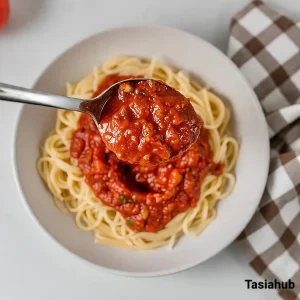
Homemade Spaghetti Sauce
This spaghetti sauce recipe is so simple, yet so delicious, you’ll wonder why you haven’t been making it all along.
Equipment
- Large Skillet or Saucepan
- Wooden spoon
- Can Opener
- Measuring spoons
- Lid for the Pan
Ingredients
For the Sauce:
- 2 tbsp olive oil
- 1 medium onion finely chopped
- 4 cloves garlic minced
- 1 can 28 oz crushed tomatoes
- 1 can 6 oz tomato paste
- 1 cup water or more, for desired thickness
- 1 tsp sugar optional, to balance acidity
- Salt and pepper to taste
For the Herbs:
- 1 tsp dried basil
- 1 tsp dried oregano
- 1/2 tsp dried thyme
- 1 bay leaf
- A pinch of red pepper flakes optional, for heat
Instructions
Step 1: Sauté the Onion and Garlic
- Place your skillet or saucepan over medium heat and add 2 tablespoons of olive oil. Let it warm up for about 1 minute.
- Add the finely chopped onion and sauté, stirring occasionally, until it becomes soft and translucent (about 3-5 minutes).
- Once the onion is ready, add the minced garlic and cook for an additional 1-2 minutes, stirring frequently. Be careful not to burn the garlic — you just want it fragrant.
- Pro Tip: Keep an eye on the garlic! It burns quickly and can make your sauce taste bitter. Stir constantly once the garlic is in the pan.
Step 2: Combine the Tomatoes and Tomato Paste
- Pour in the can of crushed tomatoes and stir to combine with the onions and garlic.
- Add the tomato paste and stir until it’s fully incorporated into the sauce.
- Pro Tip: Tomato paste is thick and sticky, so make sure to stir it well so it doesn’t clump. It’ll help thicken your sauce later.
Step 3: Simmer the Sauce
- Pour in about 1 cup of water to thin the sauce to your desired consistency. If you prefer a thicker sauce, you can add less water.
- Stir in the sugar (if using), dried basil, oregano, thyme, bay leaf, and a pinch of red pepper flakes (if you like heat). Season with salt and pepper to taste.
- Lower the heat and cover the pan, allowing the sauce to simmer for 20-25 minutes. Stir occasionally.
- Pro Tip: If the sauce thickens too much during simmering, you can add a little more water to keep it at the consistency you like.
Step 4: Taste and Adjust
- After simmering, give the sauce a taste. Add more salt, pepper, or herbs if you feel it needs a little extra kick. You can also add a pinch more sugar if it’s too tangy.
- Don’t forget to take out the bay leaf before serving — it’s there for flavor but not meant to be eaten.
- Pro Tip: Taste the sauce before serving to ensure the flavor is balanced. The right amount of seasoning makes all the difference!
Step 5: Serve and Enjoy
- Spoon the sauce over cooked spaghetti (or any pasta of your choice). Add some fresh grated Parmesan cheese on top, if desired.
- For an extra touch, sprinkle some fresh basil or parsley on top before serving.
Notes
Nutritional Value (Per Serving)
- Calories: 90–110 kcal
- Protein: 2–3g
- Carbohydrates: 12–15g
- Sugars: 5–7g
- Fat: 4–6g
- Saturated Fat: 0.5–1g
- Fiber: 2–3g
- Sodium: 350–450mg
The nutritional information provided on this website is an estimate only and is intended for general guidance. We cannot guarantee its accuracy and recommend consulting a qualified healthcare professional or registered dietitian for personalized nutrition advice.